Solvent- and Co-Catalyst-Free Cycloaddition of Carbon Dioxide and Epoxides Catalyzed by Recyclable Bifunctional Niobium Complexes
Abstract
:1. Introduction
2. Materials and Methods
2.1. Chemicals and Analytical Methods
2.2. Synthesis of Bifunctional Niobium Complexes
2.3. Experimental Procedure for the Cycloaddition of Carbon Dioxide and Epoxides
3. Results and Discussion
3.1. Optimization of Reaction Conditions
3.1.1. Effect of Catalyst Type on Catalytic Activity
3.1.2. Effect of Reaction Parameters on Catalytic Activity
3.2. Applicability of Substrates
3.3. Kinetic Study
3.4. Reusability of Catalyst
3.5. Possible Reaction Mechanisms
4. Conclusions
Supplementary Materials
Author Contributions
Funding
Institutional Review Board Statement
Informed Consent Statement
Data Availability Statement
Acknowledgments
Conflicts of Interest
References
- Dewangan, N.; Hui, W.M.; Jayaprakash, S.; Bawah, A.R.; Poerjoto, A.J.; Jie, T.; Jangam, A.; Hidajat, K.; Kawi, S. Recent Progress on Layered Double Hydroxide (LDH) Derived Metal-based Catalysts for CO2 Conversion to Valuable Chemicals. Catal. Today 2020, 356, 490–513. [Google Scholar] [CrossRef]
- Dubey, A.; Nencini, L.; Fayzullin, R.R.; Nervi, C.; Khusnutdinova, J.R. Bio-Inspired Mn(I) Complexes for the Hydrogenation of CO2 to Formate and Formamide. ACS Catal. 2017, 7, 3864–3868. [Google Scholar] [CrossRef]
- Kanega, R.; Onishi, N.; Tanaka, S.; Kishimoto, H.; Himeda, Y. Catalytic Hydrogenation of CO2 to Methanol Using Multinuclear Iridium Complexes in a Gas–Solid Phase Reaction. J. Am. Chem. Soc. 2021, 143, 1570–1576. [Google Scholar] [CrossRef] [PubMed]
- Wu, X.; Chen, C.; Guo, Z.; North, M.; Whitwood, A.C. Metal- and Halide-Free Catalyst for the Synthesis of Cyclic Carbonates from Epoxides and Carbon Dioxide. ACS Catal. 2019, 9, 1895–1906. [Google Scholar] [CrossRef]
- Zhang, Z.; Zhang, Z.H.; Zhou, F.; Zhou, J. Catalytic Enantioselective Transfer Hydrogenation–Carboxylative Cyclization to 4-Fluoroalkyl 2-Oxazolidinone with CO2 as the C1 Synthon. Org. Lett. 2021, 23, 2726–2730. [Google Scholar] [CrossRef]
- Yang, H.; Nie, H.; Wen, Q.; Ban, B.; Hu, J. Reaction Study on CO2 with Amines Catalyzed by N,N-dimethylethanolamine. J. Xuzhou Inst. Technol. Nat. Sci. Ed. 2022, 37, 9–13. [Google Scholar]
- Castro-Osma, J.A.; Comerford, J.W.; Heath, S.; Jones, O.; Morcillo, M.; North, M. Quinine Catalyzed Asymmetric Michael Additions in a Sustainable Solvent. RSC Adv. 2015, 5, 3678–3685. [Google Scholar] [CrossRef]
- Lawrenson, S.B. Greener Solvents for Solid-Phase Organic Synthesis. Pure Appl. Chem. 2018, 90, 157–165. [Google Scholar] [CrossRef]
- Yadav, N.; Seidi, F.; Crespy, D.; D’Elia, V. Polymers Based on Cyclic Carbonates as Trait d’Unionbetween Polymer Chemistry and Sustainable CO2 Utilization. ChemSusChem 2019, 12, 724–754. [Google Scholar] [CrossRef]
- Li, P.; Cao, Z.X. Catalytic Preparation of Cyclic Carbonates from CO2 and Epoxides by Metal-Porphyrin and -Corrole Complexes: Insight into Effects of Cocatalyst and meso-Substitution. Organometallics 2018, 37, 406–414. [Google Scholar] [CrossRef]
- Bragato, N.; Fiorani, G. Cyclic Organic Carbonates from Furanics: Opportunities and Challenges. Curr. Opin. Green Sustain. Chem. 2021, 30, 100479–100487. [Google Scholar] [CrossRef]
- Wang, K.; Liu, Y.X.; Wang, S.T.; Dai, Z.F.; Xiong, Y.B. Synergistic Catalysis of Metalloporphyrins and Phosphonium Ionic Liquids for the Efficient Transformation of CO2 under Ambient Conditions. J. CO2 Util. 2021, 48, 101519–101526. [Google Scholar] [CrossRef]
- Paninho, A.B.; Forte, A.; Zakrzewska, M.E.; Mahmudov, K.T.; Pombeiro, A.J.L.; Guedes da Silva, M.F.C.; Nunes da Ponte, M.; Branco, L.C.; Nunes, A.V.M. Catalytic Effect of Different Hydroxyl-Functionalised Ionic Liquids Together with Zn(II) Complex in the Synthesis of Cyclic Carbonates from CO2. Mol. Catal. 2021, 499, 111292–111296. [Google Scholar] [CrossRef]
- Wen, Q.; Yuan, X.; Zhou, Q.; Yang, H.-J.; Jiang, Q.; Hu, J.; Guo, C.-Y. Solvent-free Coupling Reaction of Carbon Dioxide and Epoxides Catalyzed by Quaternary Ammonium Functionalized Schiff Base Metal Complexes under Mild Conditions. Materials 2023, 16, 1646. [Google Scholar] [CrossRef]
- Liu, N.; Xie, Y.F.; Wang, C.; Li, S.J.; Wei, D.H.; Li, M.; Dai, B. Cooperative Multifunctional Organocatalysts for Ambient Conversion of Carbon Dioxide into Cyclic Carbonates. ACS Catal. 2018, 8, 9945–9957. [Google Scholar] [CrossRef]
- Zanda, N.; Sobolewska, A.; Alza, E.; Kleij, A.W.; Pericàs, M.A. Organocatalytic and Halide-Free Synthesis of Glycerol Carbonate under Continuous Flow. ACS Sustain. Chem. Eng. 2021, 9, 4391–4397. [Google Scholar] [CrossRef]
- Della Monica, F.; Buonerba, A.; Paradiso, V.; Milione, S.; Grassi, A.; Capacchione, C. [OSSO]-Type Fe(III) Metallate as Single-Component Catalyst for the CO2 Cycloaddition to Epoxides. Adv. Synth. Catal. 2019, 361, 283–288. [Google Scholar] [CrossRef]
- Yepes, Y.R.; Quintero, C.; Melendez, D.O.; Daniliuc, C.G.; Martínez, J.; Rojas, R. Cyclic Carbonates from CO2 and Epoxides Catalyzed by Tetra- and Pentacoordinate Amidinate Aluminum Complexes. Organometallics 2019, 38, 469–478. [Google Scholar] [CrossRef]
- Ma, R.; He, L.N.; Zhou, Y.B. An Efficient and Recyclable Tetraoxo-Coordinated Zinc Catalyst for the Cycloaddition of Epoxides with Carbon Dioxide at Atmospheric Pressure. Green Chem. 2016, 18, 226–231. [Google Scholar] [CrossRef]
- Xin, X.; Shan, H.W.; Tian, T.; Wang, Y.R. Conversion of CO2 into Cyclic Carbonates under Ambient Conditions Catalyzed by Rare-Earth Metal Complexes Bearing Poly(phenolato) Ligand. ACS Sustain. Chem. Eng. 2020, 8, 13185–13194. [Google Scholar] [CrossRef]
- Monassier, A.; D’Elia, V.; Cokoja, M.; Dong, H.; Pelletier, J.D.A.; Basset, J.-M.; Kuhn, F.E. Synthesis of Cyclic Carbonates from Epoxides and CO2 under Mild Conditions Using a Simple, Highly Efficient Niobium-Based Catalyst. ChemCatChem 2013, 5, 1321–1324. [Google Scholar] [CrossRef]
- Dutta, B.; Sofack-Kreutzer, J.; Ghani, A.A.; D’Elia, V.; Pelletier, J.D.A.; Cokoja, M.; Kuhn, F.E.; Basset, J.-M. Nucleophile-directed Selectivity towards Linear Carbonates in the Niobium Pentaethoxide-catalysed Cycloaddition of CO2 and Propylene Oxide. Catal. Sci. Technol. 2014, 4, 1534–1538. [Google Scholar] [CrossRef]
- Wilhelm, M.E.; Anthofer, M.H.; Reich, R.M.; D’Elia, V.; Basset, J.-M.; Herrmann, W.A.; Cokoja, M.; Kühn, F.E. Niobium(V) Chloride and Imidazolium Bromides as Efficient Dual Catalyst Systems for the Cycloaddition of Carbon Dioxide and Propylene Oxide. Catal. Sci. Technol. 2014, 4, 1638–1643. [Google Scholar] [CrossRef]
- Chen, A.; Chen, C.; Xiu, Y.; Liu, X.; Chen, J.; Guo, L.; Zhang, R.; Hou, Z. Niobate Salts of Organic Base Catalyzed Chemical Fixation of Carbon Dioxide with Epoxides to Form Cyclic Carbonates. Green Chem. 2016, 18, 3567–3576. [Google Scholar] [CrossRef]
- Luo, R.C.; Chen, Y.J.; He, Q.; Lin, X.W.; Xu, Q.H.; Zhang, W.Y.; Zhou, X.T.; Ji, H.B. Metallosalen-Based Ionic Porous Polymers as Bifunctional Catalysts for the Conversion of CO2 into Valuable Chemicals. ChemSusChem 2017, 10, 1526–1533. [Google Scholar] [CrossRef]
- Yang, H.; Nie, H.; Wen, Q.; Ban, B.; Hu, J. Cycloaddition Reaction of Azridinane and CO2 Catalyzed by Bifunctional Zinc Catalyst. J. Xuzhou Inst. Technol. Nat. Sci. Ed. 2022, 37, 28–35. [Google Scholar]
- Peng, J.; Yang, H.-J.; Wang, S.; Ban, B.; Wei, Z.; Lei, B.; Guo, C.-Y. Efficient Solvent-free Fixation of CO2 Catalyzed by New Recyclable Bifunctional Metal Complexes. J. CO2 Util. 2018, 24, 1–9. [Google Scholar] [CrossRef]
- Xu, J.; Wu, F.; Jiang, Q.; Li, Y.X. Mesoporous Carbon Nitride Grafted with N-Bromobutane: A High-Performance Heterogeneous Catalyst for the Solvent-Free Cycloaddition of CO2 to Propylene Carbonate. Catal. Sci. Technol. 2015, 5, 447–454. [Google Scholar] [CrossRef]
- Xu, J.; Wu, F.; Jiang, Q.; Shang, J.K.; Li, Y.X. Metal Halides Supported on Mesoporous Carbon Nitride as Efficient Heterogeneous Catalysts for the Cycloaddition of CO2. J. Mol. Catal. A Chem. 2015, 403, 77–83. [Google Scholar] [CrossRef]
- Han, L.; Li, H.; Choi, S.J.; Park, M.S.; Lee, S.M.; Kim, Y.J.; Park, D.W. Ionic liquids Grafted on Carbon Nanotubes as Highly Efficient Heterogeneous Catalysts for the Synthesis of Cyclic Carbonates. Appl. Catal. A Gen. 2012, 429, 67–72. [Google Scholar] [CrossRef]
- Liu, M.; Liang, L.; Li, X.; Gao, X.; Sun, J. Novel Urea Derivative-based Ionic Liquids with Dual-functions: CO2 Capture and Conversion under Metal- and Solvent-free Conditions. Green Chem. 2016, 18, 2851–2863. [Google Scholar] [CrossRef]
- Kim, Y.; Ryu, S.; Cho, W.; Kim, M.; Park, M.H.; Kim, Y. Halide-Free and Bifunctional One-Component Catalysts for the Coupling of Carbon Dioxide and Epoxides. Inorg. Chem. 2019, 58, 5922–5931. [Google Scholar] [CrossRef]
- Kiriratnikom, J.; Laiwattanapaisarn, N.; Vongnam, K.; Thavornsin, N.; Sae-ung, P.; Kaeothip, S.; Euapermkiati, A.; Namuangruk, S.; Phomphrai, K. Highly Active Chromium Complexes Supported by Constrained Schiff-Base Ligands for Cycloaddition of Carbon Dioxide to Epoxides. Inorg. Chem. 2021, 60, 6147–6151. [Google Scholar] [CrossRef]
- Zhang, Q.; Yu, P.; Lei, B.; Yang, H.-J.; Hu, J.; Wang, L.; Zhou, T.; Jiang, Q.; Zhu, J.; Han, B. Efficient Solvent-free Synthesis of Cyclic Carbonates from the Cycloaddition of Carbon Dioxide and Epoxides Catalyzed by New Imidazolinium Functionalized Metal Complexes under 0.1 MPa. Catal. Lett. 2020, 150, 2537–2548. [Google Scholar] [CrossRef]
- Castro-Osma, J.A.; Lamb, K.J.; North, M. Cr(salophen) Complex Catalyzed Cyclic Carbonate Synthesis at Ambient Temperature and Pressure. ACS Catal. 2016, 6, 5012–5025. [Google Scholar] [CrossRef]
- Monica, F.D.; Kleij, A.W. Mechanistic Guidelines in Nonreductive Conversion of CO2: The Case of Cyclic Carbonates. Catal. Sci. Technol. 2020, 10, 3483–3501. [Google Scholar] [CrossRef]
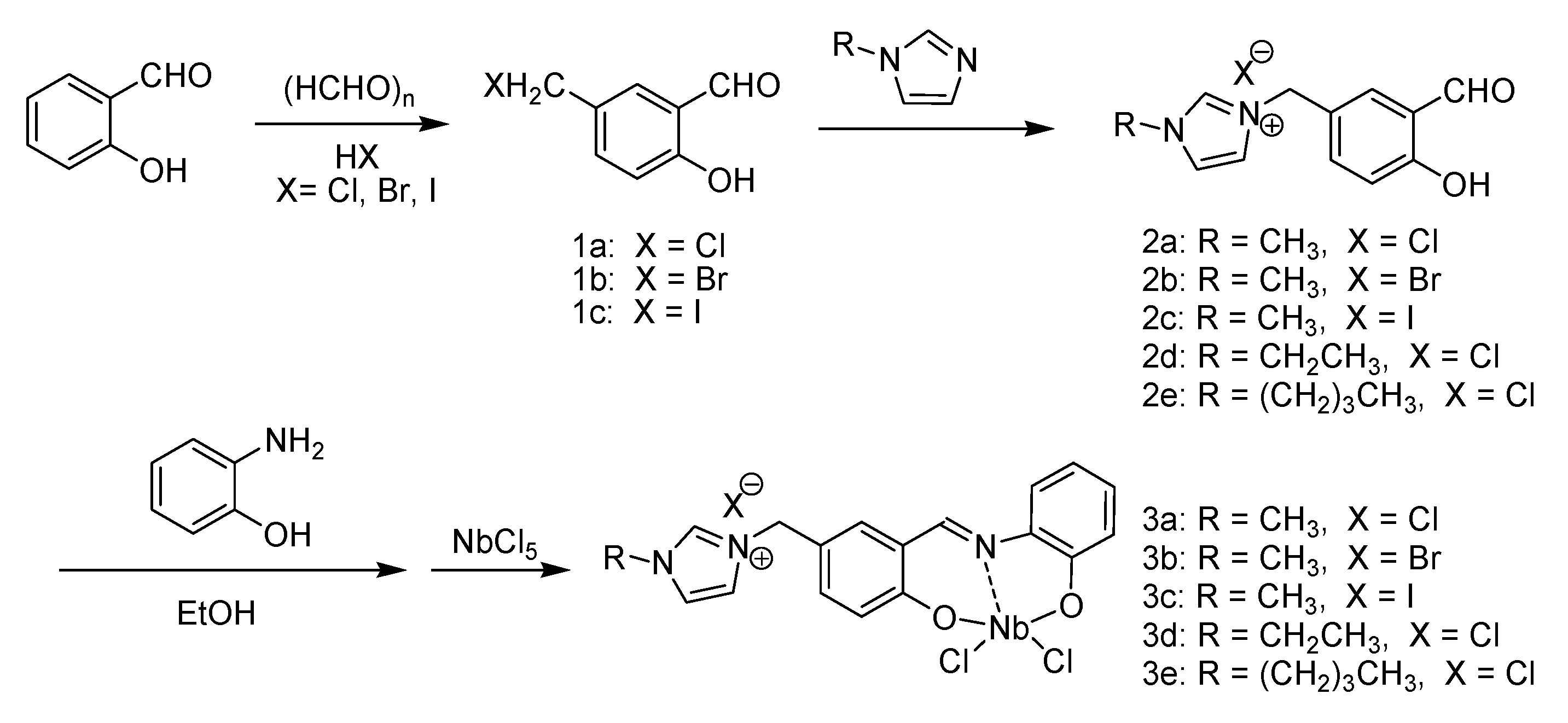

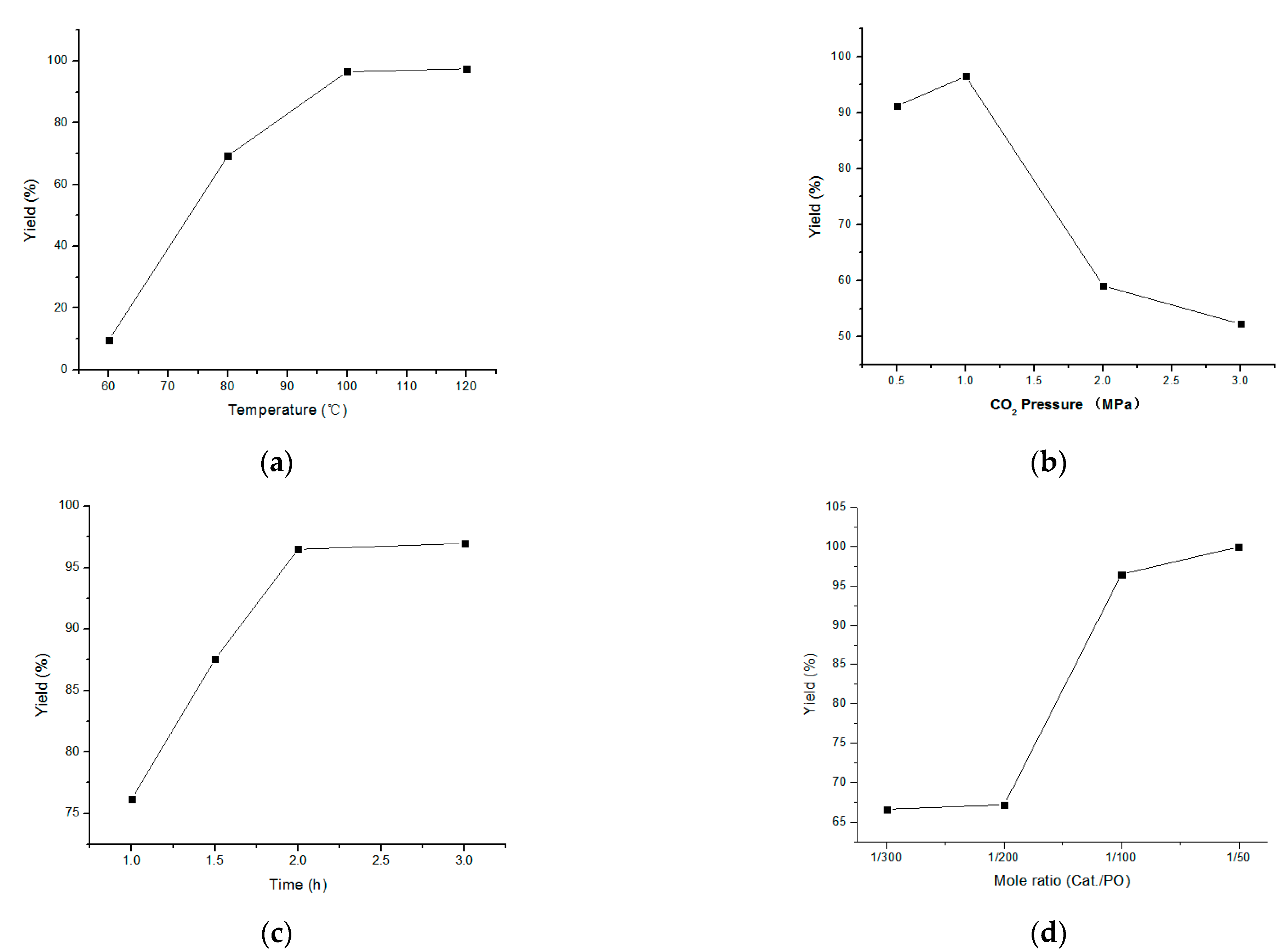
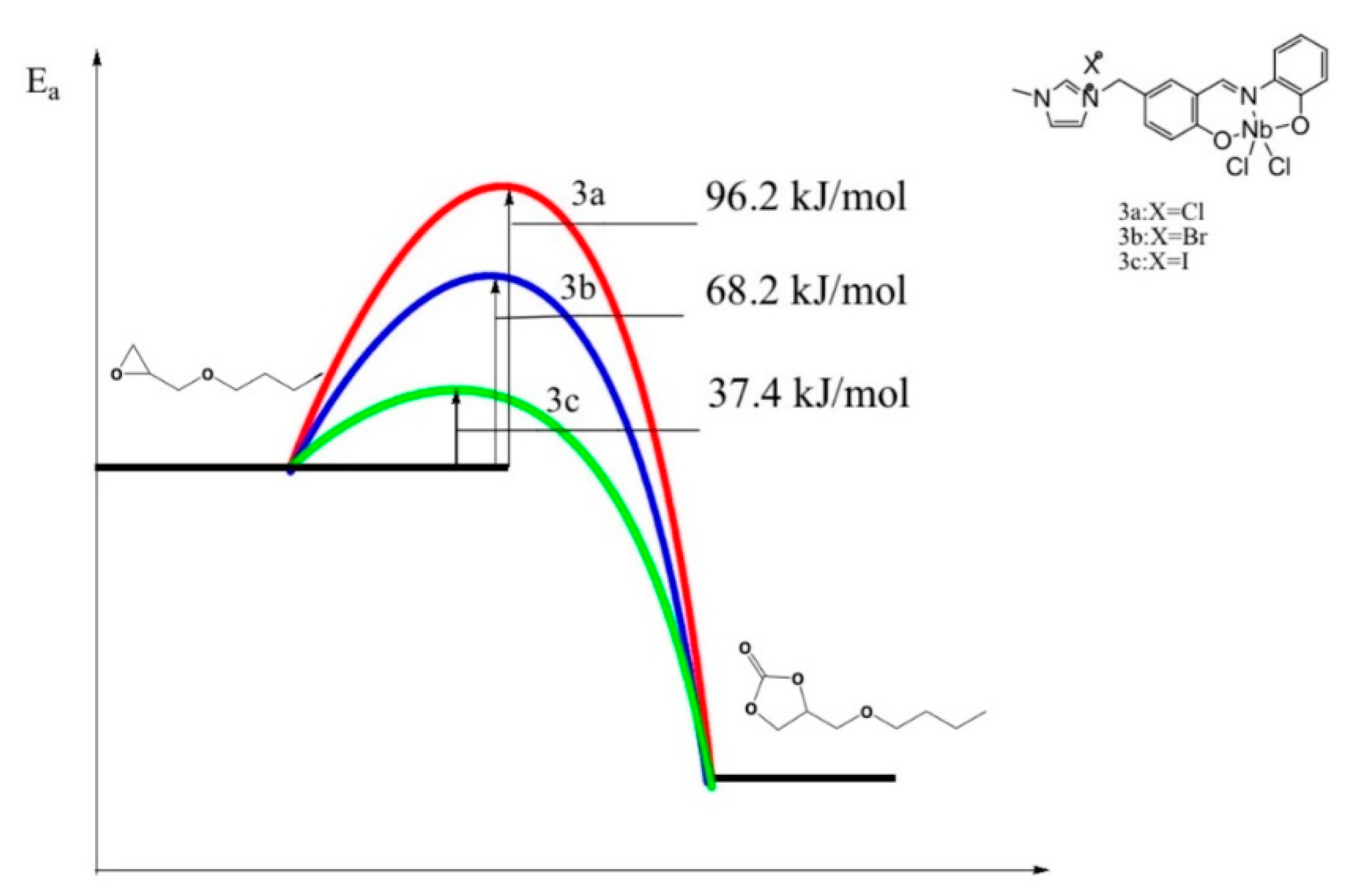
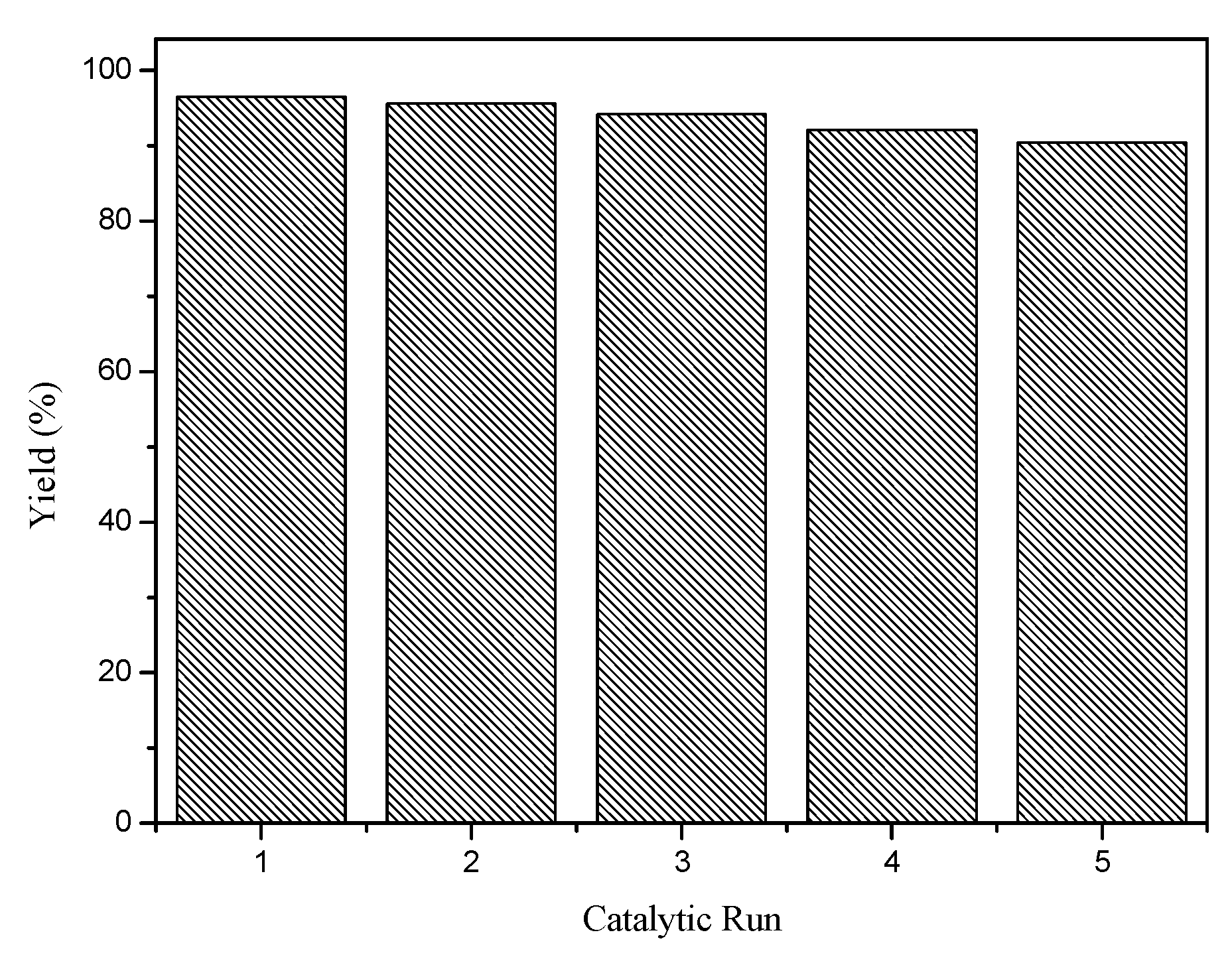
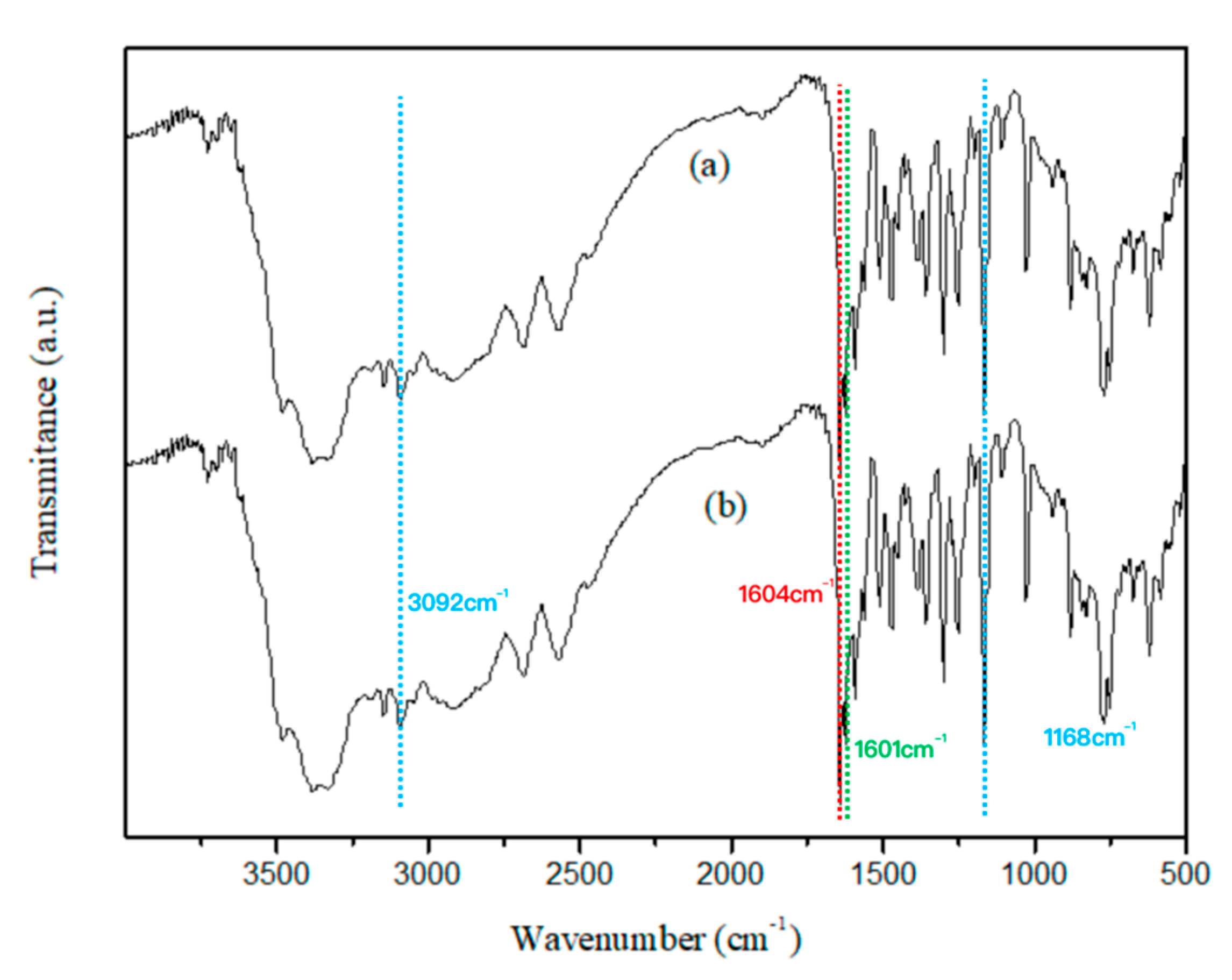

| Entry | Catalyst | PC yield (%) c | Selectivity (%) |
|---|---|---|---|
| 1 | - | - | - |
| 2 | 2a | 78 | 99 |
| 3 | 2b | 83 | 99 |
| 4 | 2c | 89 | 99 |
| 5 | 2d | 75 | 99 |
| 6 | 2e | 73 | 99 |
| 7 | 3a | 96 | 99 |
| 8 | 3b | 97 | 99 |
| 9 | 3c | 99 | 99 |
| 10 | 3d | 49 | 99 |
| 11 | 3e | 32 | 99 |
| 12 | 3f | 13 | 98 |
| 13 b | 3a | 76 | 99 |
| 14 b | 3b | 78 | 99 |
| 15 b | 3c | 79 | 99 |
| Entry | Epoxides | Product | Condition A a | Condition B b | ||
|---|---|---|---|---|---|---|
| Time (h) | Yield (%) | Time (h) | Yield (%) | |||
| 1 |  |  | 2 | 100 | 14 | 99.0 |
| 2 |  |  | 2 | 96.4 | 24 | 49.3 |
| 3 |  |  | 2 | 90.9 | 24 | 98.4 |
| 4 |  |  | 2 | 74.8 | 24 | 89.1 |
| 5 |  |  | 12 | 41.7 | 24 | 10.0 |
| 6 |  |  | 12 | 69.9 | - | - |
| 7 |  |  | 2 | 87.1 | 24 | 48.9 |
| 8 |  |  | 2 | 91.3 | 24 | 91.5 |
| 9 |  |  | 2 | 81.1 | 33 | 94.8 |
| 10 |  |  | 2 | 80.5 | 36 | 93.1 |
| 11 |  |  | 2 | 99.9 | 11 | 96.8 |
| 12 |  |  | 2 | 96.4 | 36 | 94.3 |
Disclaimer/Publisher’s Note: The statements, opinions and data contained in all publications are solely those of the individual author(s) and contributor(s) and not of MDPI and/or the editor(s). MDPI and/or the editor(s) disclaim responsibility for any injury to people or property resulting from any ideas, methods, instructions or products referred to in the content. |
© 2023 by the authors. Licensee MDPI, Basel, Switzerland. This article is an open access article distributed under the terms and conditions of the Creative Commons Attribution (CC BY) license (https://creativecommons.org/licenses/by/4.0/).
Share and Cite
Wen, Q.; Yuan, X.; Zhou, Q.; Yang, H.-J.; Jiang, Q.; Hu, J.; Guo, C.-Y. Solvent- and Co-Catalyst-Free Cycloaddition of Carbon Dioxide and Epoxides Catalyzed by Recyclable Bifunctional Niobium Complexes. Materials 2023, 16, 3531. https://doi.org/10.3390/ma16093531
Wen Q, Yuan X, Zhou Q, Yang H-J, Jiang Q, Hu J, Guo C-Y. Solvent- and Co-Catalyst-Free Cycloaddition of Carbon Dioxide and Epoxides Catalyzed by Recyclable Bifunctional Niobium Complexes. Materials. 2023; 16(9):3531. https://doi.org/10.3390/ma16093531
Chicago/Turabian StyleWen, Qin, Xuexin Yuan, Qiqi Zhou, Hai-Jian Yang, Qingqing Jiang, Juncheng Hu, and Cun-Yue Guo. 2023. "Solvent- and Co-Catalyst-Free Cycloaddition of Carbon Dioxide and Epoxides Catalyzed by Recyclable Bifunctional Niobium Complexes" Materials 16, no. 9: 3531. https://doi.org/10.3390/ma16093531







